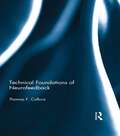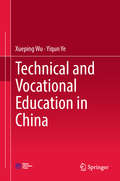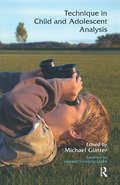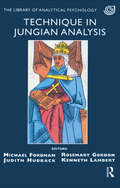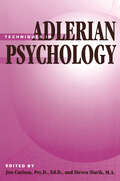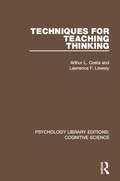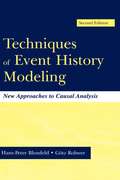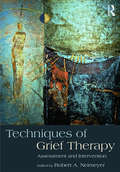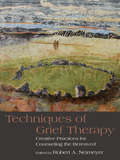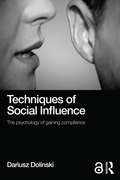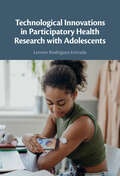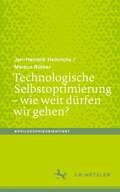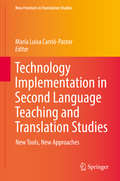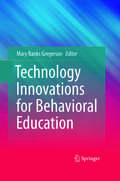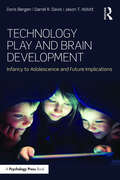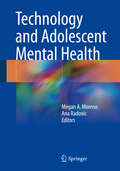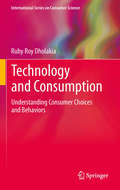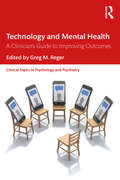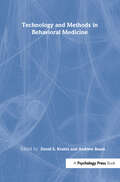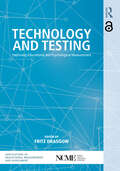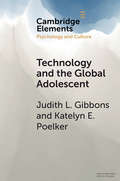- Table View
- List View
Technical Foundations of Neurofeedback
by Thomas F. ColluraTechnical Foundations of Neurofeedback provides, for the first time, an authoritative and complete account of the scientific and technical basis of EEG biofeedback. Beginning with the physiological origins of EEG rhythms, Collura describes the basis of measuring brain activity from the scalp and how brain rhythms reflect key brain regulatory processes. He then develops the theory as well as the practice of measuring, processing, and feeding back brain activity information for biofeedback training. Combining both a "top down" and a "bottom up" approach, Collura describes the core scientific principles, as well as current clinical experience and practical aspects of neurofeedback assessment and treatment therapy. Whether the reader has a technical need to understand neurofeedback, is a current or future neurofeedback practitioner, or only wants to understand the scientific basis of this important new field, this concise and authoritative book will be a key source of information..
Technical and Vocational Education in China
by Xueping Wu Yiqun YeThis book provides comprehensive and up-to-date coverage of research on technical and vocational education in China. It discusses various aspects that range from such conventional topics as teaching at different levels, development history, regulations, policies, curriculum, specialty setup, teaching, faculty and management; to the status quo, transformation and current trends; as well as quantity expansion and quality improvement, all of which highlight the unique characteristics of technical and vocational education in China.This book is intended for researchers and graduate students, and will also help international readers to grasp the general situation regarding technical and vocational education in China. Combining rich content and a broad scope, the book will undoubtedly offer a valuable key to understanding China’s technical and vocational education in the 21st century.
Techniken für optimale Gesprächsführung: Wie Sie in Alltag und Berufsleben Gespräche erfolgreich führen (essentials)
by Thomas BindelThomas Bindel schlägt Ihnen vor, mit welchen Worten Sie in schwierigen Situationen richtig reagieren. Er verrät Ihnen, mit welcher Systematik Sie Gespräche und Verhandlungen perfekt vorbereiten. Und er zeigt Ihnen, wie Sie mit Menschen vertieft ins Gespräch kommen, indem Sie besser zuhören und treffende Fragen stellen. Das vorliegende Buch bietet somit ein Konzentrat aus den wichtigsten Methoden, um Gespräche optimal führen zu können: Ausgestattet mit dem Erfolgsprinzip eines amerikanischen Präsidenten, diversen Denkhüten, passenden Strategien und Techniken für Gesprächsvorbereitung, -führung sowie -nachbereitung übersteht man die Begegnung mit dem Freud&’schen Eisberg und findet so zu einer Kommunikation, die durch ein Quadrat runder läuft und gewaltfrei mehr erreicht.
Technique in Child and Adolescent Analysis
by Michael Günter Harriett HasencleverThese are the edited papers from a conference held in 2008 on the topic of problems with child and adolescent analysis. The contributors come from widely differing theoretical backgrounds and use a broad variety of metapsychological concepts, among them contemporary Kleinian, post-Bionian classical Freudian. This collection helps widen our understanding of technique with children and adolescents and together they show a very modern psychoanalytic technique may be emerging from modern recent work with children and adolescents.
Technique in Jungian Analysis (The\library Of Analytical Psychology Ser.)
by Kenneth Lambert Michael Fordham Rosemary Gordon Judith HubbackThis volume will be of enormous interest and value to the growing number of people qualified both in the established and the new training societies for analysts and therapists, or studying to enter them. Within it theory and practice are closely interwoven, demonstrating how theories and models emerge, both from the study of earlier pioneering publications and from day to day experience, and are tested time and time again in the process of a group of practitioners accepting them as viable. An impressive and creative blend of the characteristics which this profession demands of its practitioners is in evidence here, combining originality with passion for their subject and the flexibility required to develop their own pattern of thought. 'In the practice of modern analytical psychology it has become of central importance to reorganise, analyse and interpret projections and introjections of many sorts, the patient's transference, the analyst's counter-transference, and the dialectical interaction between the two, which is descriptively termed transference/counter-transference.
Techniques In Adlerian Psychology
by Jon Carlson Steven SlavikFirst published in 1998. Routledge is an imprint of Taylor & Francis, an informa company.
Techniques for Teaching Thinking (Psychology Library Editions: Cognitive Science)
by Lawrence F. Lowery Arthur CostaOriginally published in 1989 the purpose of this title was to provide information and ideas for: Staff Developers and Teacher Educators, as they consider program content to prepare teachers to teach thinking skills. Teachers, as they assess their own abilities to create classroom conditions for thinking and their readiness to implement a curriculum for developing thinking skills. Curriculum Developers, as they decide how the curriculum should be organized and sequenced according to children’s developmental levels. Administrators, as they assess and provide leadership for improving the conditions in their schools and classrooms, which allows the stimulating teaching of thinking. Although written some time ago the information is still valid today.
Techniques for the Couple Therapist: Essential Interventions from the Experts
by Gerald R. Weeks Stephen T. Fife Colleen M. PetersonTechniques for the Couple Therapist features many of the most prominent psychotherapists today, presenting their most effective couple therapy interventions. This book provides clinicians with a user-friendly quick reference with an array of techniques that can be quickly read and immediately used in session. The book includes over 50 chapters by experts in the field on the fundamental principles and techniques for effective couple therapy. Many of the techniques focus on common couple therapy processes such as enactments, communication, and reframing. Others focus on specific presenting problems, such as trauma, sexual issues, infidelity, intimate partner violence, and high conflict. Students, beginning therapists, and seasoned clinicians will find this pragmatic resource invaluable in their work with couples.
Techniques in Marriage and Family Counseling
by Richard E. WattsEighteen chapters covering assessment, transgenerational, and constructive techniques share contributors' adaptations of the family counseling literature to clinical realities. Appends The How I Remember My Family Questionnaire. Lacks an index.
Techniques of Event History Modeling: New Approaches to Casual Analysis
by Hans-Peter Blossfeld G”tz RohwerIncluding new developments and publications which have appeared since the publication of the first edition in 1995, this second edition: *gives a comprehensive introductory account of event history modeling techniques and their use in applied research in economics and the social sciences; *demonstrates that event history modeling is a major step forward in causal analysis. To do so the authors show that event history models employ the time-path of changes in states and relate changes in causal variables in the past to changes in discrete outcomes in the future; and *introduces the reader to the computer program Transition Data Analysis (TDA). This software estimates the sort of models most frequently used with longitudinal data, in particular, discrete-time and continuous-time event history data. Techniques of Event History Modeling can serve as a student textbook in the fields of statistics, economics, the social sciences, psychology, and the political sciences. It can also be used as a reference for scientists in all fields of research.
Techniques of Grief Therapy: Assessment and Intervention (Series in Death, Dying, and Bereavement)
by Robert A. NeimeyerTechniques of Grief Therapy: Assessment and Intervention continues where the acclaimed Techniques of Grief Therapy: Creative Practices for Counseling the Bereaved left off, offering a whole new set of innovative approaches to grief therapy to address the needs of the bereaved. This new volume includes a variety of specific and practical therapeutic techniques, each conveyed in concrete detail and anchored in an illustrative case study. Techniques of Grief Therapy: Assessment and Intervention also features an entire new section on assessment of various challenges in coping with loss, with inclusion of the actual scales and scoring keys to facilitate their use by practitioners and researchers. Providing both an orientation to bereavement work and an indispensable toolkit for counseling survivors of losses of many kinds, this book belongs on the shelf of both experienced clinicians and those just beginning to delve into the field of grief therapy.
Techniques of Grief Therapy: Creative Practices for Counseling the Bereaved (Series in Death, Dying, and Bereavement)
by Robert A. NeimeyerTechniques of Grief Therapy is an indispensable guidebook to the most inventive and inspirational interventions in grief and bereavement counseling and therapy. Individually, each technique emphasizes creativity and practicality. As a whole, they capture the richness of practices in the field and the innovative approaches that clinicians in diverse settings have developed, in some cases over decades, to effectively address the needs of the bereaved. New professionals and seasoned clinicians will find dozens of ideas that are ready to implement and are packed with useful features, including: Careful discussion of the therapeutic relationship that provides a "container" for specific procedures An intuitive, thematic organization that makes it easy to find the right technique for a particular situation Detailed explanations of when to use (and when not to use) particular techniques Expert guidance on implementing each technique and tips on avoiding common pitfalls Sample worksheets and activities for use in session and as homework assignments Illustrative case studies and transcripts Recommended readings to learn more about theory, research and practice associated with each technique
Techniques of Pleasure: BDSM and the Circuits of Sexuality
by Margot WeissTechniques of Pleasure is a vivid portrayal of the San Francisco Bay Area's pansexual BDSM (SM) community. Margot Weiss conducted ethnographic research at dungeon play parties and at workshops on bondage, role play, and flogging, and she interviewed more than sixty SM practitioners. She describes a scene devoted to a form of erotic play organized around technique, rules and regulations, consumerism, and self-mastery. Challenging the notion that SM is inherently transgressive, Weiss links the development of commodity-oriented sexual communities and the expanding market for sex toys to the eroticization of gendered, racialized, and national inequalities. She analyzes the politics of BDSM's spectacular performances, including those that dramatize heterosexual male dominance, slave auctions, and US imperialism, and contends that the SM scene is not a "safe space" separate from real-world inequality. It depends, like all sexual desire, on social hierarchies. Based on this analysis, Weiss theorizes late-capitalist sexuality as a circuit--one connecting the promise of new emancipatory pleasures to the reproduction of raced and gendered social norms.
Techniques of Social Influence: The psychology of gaining compliance
by Dariusz DolinskiEvery day we are asked to fulfil others’ requests, and we make regular requests of others too, seeking compliance with our desires, commands and suggestions. This accessible text provides a uniquely in-depth overview of the different social influence techniques people use in order to improve the chances of their requests being fulfilled. It both describes each of the techniques in question and explores the research behind them, considering questions such as: How do we know that they work? Under what conditions are they more or less likely to be effective? How might individuals successfully resist attempts by others to influence them? The book groups social influence techniques according to a common characteristic: for instance, early chapters describe "sequential" techniques, and techniques involving egotistic mechanisms, such as using the name of one’s interlocutor. Later chapters present techniques based on gestures and facial movements, and others based on the use of specific words, re-examining on the way whether "please" really is a magic word. In every case, author Dariusz Dolinski discusses the existing experimental studies exploring their effectiveness, and how that effectiveness is enhanced or reduced under certain conditions. The book draws on historical material as well as the most up-to-date research, and unpicks the methodological and theoretical controversies involved. The ideal introduction for psychology graduates and undergraduates studying social influence and persuasion, Techniques of Social Influence will also appeal to scholars and students in neighbouring disciplines, as well as interested marketing professionals and practitioners in related fields.
Technological Innovations in Participatory Health Research with Adolescents
by Leonor Rodriguez-EstradaThis book offers a critical overview of participatory methods in health research with adolescents and youth. It introduces participatory methodology as an ethos and practice, before covering specific paradigms and methods, including participatory action research, community-based participatory research, co-design, co-creation, participatory design, peer research, youth as researchers, integrated knowledge translation, and youth-adult partnerships. Specific technologies are also covered, such as mobile apps and video games, sonification, photovoice, visual mapping, and Internet-based approaches. A guidebook to both theory and methods, it demonstrates technology's potential to drive impactful research and inclusive study design.
Technologische Selbstoptimierung – wie weit dürfen wir gehen? (#philosophieorientiert)
by Jan-Hendrik Heinrichs Markus RütherTechnologische Selbstoptimierung ist gegenwärtig in aller Munde. Sie umfasst die Erforschung neuer Möglichkeiten im Hinblick auf Schönheitsoperationen, funktionale Implantologie, Gehirndoping oder die Verlängerung der Lebensspanne. Gegenüber vielen dieser technischen Mittel, die oft nicht legal verfügbar sind, bestehen erhebliche gesellschaftliche Vorbehalte. Jan-Hendrik Heinrichs und Markus Rüther plädieren bei ihrer ethischen Einschätzung für eine Differenzierung der Perspektive: Die Vorbehalte sind nämlich ihrer Meinung nach nicht geeignet, gesellschaftliche Ächtung oder gar verbindliche Verbote für alle zu begründen. Vielmehr habe die Freiheit zur Selbstgestaltung Vorrang, was jedoch nicht heißt, dass es für manche Bereiche nicht auch klare Regeln geben muss. Weil Selbstgestaltung aber nur frei sein kann, wenn sie informiert ist, argumentieren die Autoren für Regelungen, die von weitgehenden Informationspflichten statt von Verboten bestimmt sind. Aus einer individuellen Sicht heraus lassen sich zudem eine Reihe von moralischen Empfehlungen formulieren, die zwar nicht eingefordert werden können, aber einen ethischen Kompass bilden, um sich im Dickicht der ethischen Debatte an guten Gründen zu orientieren.
Technology Implementation in Second Language Teaching and Translation Studies
by María Luisa Carrió-PastorThis monograph mainly focuses on the idea that language teaching in higher education involves making use of new approaches and technology. It identifies the key determinants of the materials needed to improve language teaching on the basis of the actual experimental research included in the respective contributions. Thanks to its unique perspective, the book offers a distinctive approach to addressing empirical research on second language teaching, translator training and technology. As universities are some of the best arenas for analyzing teaching techniques for various subjects, higher education teachers can use this book to thoroughly prepare for the application of pilot studies and learn more about students' responses to new teaching and translation techniques. An enlightening guide for scholars and students with an academic interest in acquiring the basic principles of language teaching and translation, this book mainly provides actual cases in which the implementation of technology was useful to second language teachers and translation trainers. As the authors are experienced scholars, readers will not only come to understand how to use new teaching strategies, but also discover that the proposals described in each chapter can be useful to any level of second language training for teachers and translators.
Technology Innovations for Behavioral Education
by Mary Banks GregersonBehavioral and technological innovation has a special place in the future of graduate and medical education, both for students and for educators. A new multi-media pedagogy offers innovative techniques and technologies, drawing widely upon behavioral science. The psychology of multi-media education maximizes learning by involving many different sensory modalities. Although multi-media has long meant use of film and other electronic modality adjuncts like Powerpoint, newer technologies expand these horizons further. Now multi-media pedagogy means not only newer technologies, but also newer, and different education techniques. This book describes psychology innovation currently making educational settings competent and competitive. Student choice rules in education today. The technologically driven environment produces students whose preference is incumbent on electronic research means. Besides using these tools themselves, students thirst for multi-media pedagogy in the classroom online and on campus. It is therefore teachers who close the digital divide between generations in order to educate effectively. Approaches using new technologies and techniques have proven successful internationally with diverse audiences.
Technology Play and Brain Development: Infancy to Adolescence and Future Implications
by Doris Bergen Darrel R. Davis Jason T. AbbittTechnology Play and Brain Development brings together current research on play development, learning technology, and brain development. The authors first navigate the play technology and brain development interface, highlighting the interactive qualities that make up each component. Next, they survey the changes in play materials and the variations in time periods for play that have occurred over the past 15-20 years, and then explain how these changes have had the potential to affect this play/brain developmental interaction. The authors also cover various types of technology-augmented play materials used by children at age levels from infancy to adolescence, and describe the particular qualities that may enhance or change brain development. In so doing, they present information on previous and current studies of the play and technology interface, in addition to providing behavioral data collected from parents and children of varied ages related to their play with different types of play materials. Significantly, they discuss how such play may affect social, emotional, moral, and cognitive development, and review futurist predictions about the potential qualities of human behavior needed by generations to come. The authors conclude with advice to toy and game designers, parents, educators, and the wider community on ways to enhance the quality of technology-augmented play experiences so that play will continue to promote the development of human characteristics needed in the future.
Technology and Adolescent Mental Health
by Megan A. Moreno Ana RadovicThis comprehensive book provides a framework for healthcare providers working with the dual challenges and opportunities presented by the intersection of mental health and technology. Technology and Adolescent Mental Health provides recent, evidence-based approaches that are applicable to clinical practice and adolescent care, with each chapter including a patient case illustrating key components of the chapter contents. Early chapters address the epidemiology of mental health, while the second section of the book deals with how both offline and online worlds affect mental health, presenting both positive and negative outcomes, and focusing on special populations of at-risk adolescents. The third section of the book focuses on technology uses for observation, diagnosis or screening for mental health conditions. The final section highlights promising future approaches to technology, and tools for improving intervention and treatment for mental health concerns and illnesses. This book will be a key resource for pediatricians, family physicians, internal medicine providers, adolescent medicine and psychiatry specialists, psychologists, social workers, as well as any other healthcare providers working with adolescents and mental health care.
Technology and Consumption
by Ruby Roy DholakiaTechnology and Household Consumption is a comprehensive text that provides insights into technology's impact on consumer behavior and the household environment. Consumption and consumer behavior has become a very important subject of study that is now covered in many disciplines including family economics, culture studies, and feminist/women studies. In the first section, this book provides a historical perspective on how consumer behaviors have changed because of technology and how technology itself has changed. Data on ownership and expenditures is detailed in describing the penetration of technology in the household and changes over time. In the examination of demographics and social changes, an emphasis is placed on women and children. As it is important to understand the entry paths and factors that influence them, the book also introduces a research framework to understanding the adoption and utilization of household technologies. In the second section, the book examines specific household technologies and consumption experiences including shopping choices and behaviors, entertainment outlets and availability, communications technologies, and working at home. The book concludes with a section on the relationships between marketers and consumers.
Technology and Mental Health: A Clinician's Guide to Improving Outcomes (Clinical Topics in Psychology and Psychiatry)
by Greg M. RegerTechnology and Mental Health provides mental health clinicians with expert, practical, clinical advice on the questions and considerations associated with the adoption of mental health technology tools in the computer age. Increasingly, clinicians want to use technology to provide clients support through smartphones and mobile applications or to reach clients in remote or rural areas. However, using these tools in practice raises many practical and ethical questions. The book explains current technological developments in therapy, including mobile apps, telemental health, and virtual reality programs. Each chapter gives real-world guidance on adopting and using technology interventions, and the book spans a wide range of populations. Providers are introduced to the evidence supporting various technology-based interventions and areas for future development. Combining theory, research, and case studies, this practical guide teaches clinicians how to integrate technology into therapeutic interventions with clients.
Technology and Methods in Behavioral Medicine (Perspectives on Behavioral Medicine Series)
by Andrew S. Baum David S. KrantzThis book provides an illustrative overview of some of the key methodological and technical innovations that form the cutting edge of current research in behavioral medicine. It is divided into three sections. Part I consists of six chapters describing the impact on behavioral medicine research of novel developments in diverse areas such as molecular genetics, neuroendocrine assessment, laboratory radionuclide measurement of cardiac function, and the development of electronic event monitors for measuring compliance with medication regimens. In addition, new applications of long-available assessment techniques in clinical neuropsychology to behavioral issues in cardiovascular disease are reviewed. Part II includes four chapters which review methods and programs of research dealing with aspects of the ambulatory monitoring of moods and behavioral activities in conjunction with a variety of physiological processes and/or disease states. Finally, Part III provides two chapters which focus on novel theoretical and/or conceptual approaches--instead of the typical methodological innovations--that have guided recent research in behavioral oncology and in cardiovascular disease and the clustering syndrome of cardiovascular risk factors that relate to insulin metabolism.
Technology and Testing: Improving Educational and Psychological Measurement
by Fritz DrasgowFrom early answer sheets filled in with number 2 pencils, to tests administered by mainframe computers, to assessments wholly constructed by computers, it is clear that technology is changing the field of educational and psychological measurement. The numerous and rapid advances have immediate impact on test creators, assessment professionals, and those who implement and analyze assessments. This comprehensive new volume brings together leading experts on the issues posed by technological applications in testing, with chapters on game-based assessment, testing with simulations, video assessment, computerized test development, large-scale test delivery, model choice, validity, and error issues. Including an overview of existing literature and ground-breaking research, each chapter considers the technological, practical, and ethical considerations of this rapidly-changing area. Ideal for researchers and professionals in testing and assessment, Technology and Testing provides a critical and in-depth look at one of the most pressing topics in educational testing today.
Technology and the Global Adolescent (Elements in Psychology and Culture)
by Judith L. Gibbons Katelyn E. PoelkerAround the world, adolescents use technology for education, to further their identity and socio-emotional development, to access health information, engage in civic activities, and for entertainment. For many, technological advances, especially social media, have drastically influenced how they communicate with family, friends, and romantic partners. Challenges of technology use include the digital divide, internet addiction, and exposure to cyberbullying. The diversity of adolescents' cultural context results in heterogeneous bidirectional influences of technology and teenagers with respect to education and close relationships. Researchers, parents, and policy makers must consider the role of culture in the complex interactions of teenagers with technology.
